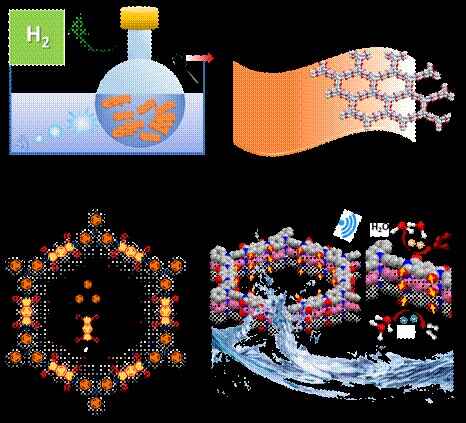
Scientists have introduced an innovative, metal-free porous organic catalyst that efficiently generates hydrogen fuel by harnessing mechanical energy, offering a sustainable and economical solution for clean energy production.
To combat global warming and reduce the environmental impact of fossil fuels, transitioning to renewable energy sources is essential. Green hydrogen (H₂) has emerged as a clean and sustainable energy carrier, producing only water as a byproduct when utilized in fuel cells. Acknowledging its significance, the Government of India has initiated the National Green Hydrogen Mission to promote large-scale production, research, and innovation in the hydrogen sector.
Among the various methods for hydrogen production, overall water splitting stands out as an effective and scalable technique. This process, however, requires efficient catalysts due to its energy-intensive nature. Piezo catalysis has gained attention as a promising approach, leveraging mechanical energy to drive water splitting through piezoelectric materials.
In a groundbreaking study published in Advanced Functional Materials, Professor Tapas K. Maji and his research team at the Jawaharlal Nehru Centre for Advanced Scientific Research (JNCASR), Bengaluru, have developed a novel metal-free covalent organic framework (COF) for efficient piezocatalytic water splitting. This COF is constructed from imide linkages between the organic donor molecule tris(4-aminophenyl)amine (TAPA) and the acceptor molecule pyromellitic dianhydride (PDA), exhibiting unique ferrielectric (FiE) ordering. The FiE ordering enhances charge generation at the pore surfaces, facilitating efficient hydrogen production.
This innovation challenges the traditional reliance on heavy metal-based ferroelectric materials for piezocatalysis, which often suffer from limited surface charge and rapid activity saturation. The sponge-like porous structure of the COF allows water molecules to access and utilize the abundant charge carriers effectively, resulting in superior hydrogen yields compared to conventional oxide-based inorganic piezocatalysts.
This advancement not only underscores the potential of metal-free catalysts in sustainable hydrogen production but also aligns with global efforts to develop clean and efficient energy solutions.
Researchers at the Jawaharlal Nehru Centre for Advanced Scientific Research (JNCASR) in Bengaluru have developed a novel, cost-effective, metal-free porous organic catalyst for efficient hydrogen (H₂) production by harvesting mechanical energy. Led by Professor Tapas K. Maji, the team constructed a covalent organic framework (COF) using a simple donor molecule, tris(4-aminophenyl)amine (TAPA), and an acceptor molecule, pyromellitic dianhydride (PDA). This COF exhibits strong charge transfer properties, creating dipoles that facilitate efficient piezocatalytic water splitting.
The unique propeller-like shape of TAPA units induces a twist in the benzene rings, breaking the flat symmetry and stabilizing the structure. Collaborating with Professor Umesh V. Waghmare’s team at JNCASR, theoretical analyses revealed that the COF possesses an unusual electronic structure with energy bands that couple and resonate through dipolar ordering. This leads to ferrielectric (FiE) ordering, where the dipoles interact with the material’s flexible twisting molecular motion, making them responsive to mechanical pressure. Consequently, the material generates electron-hole pairs upon mechanical stimulation, acting as a highly efficient piezocatalyst for water splitting to produce hydrogen.
The research team includes Ms. Adrija Ghosh, Ms. Surabhi Menon, Dr. Sandip Biswas, and Dr. Anupam Dey from JNCASR. Additionally, Dr. Supriya Sahoo and Professor Ramamoorthy Boomishankar from the Indian Institute of Science Education and Research, Pune, and Professor Jan K. Zaręba from Wrocław University of Science and Technology, Poland, contributed significantly to this interdisciplinary study.
This breakthrough demonstrates the potential of metal-free, porous heterogeneous catalysts in sustainable hydrogen production by harnessing mechanical energy, aligning with global efforts to develop clean and efficient energy solutions.
